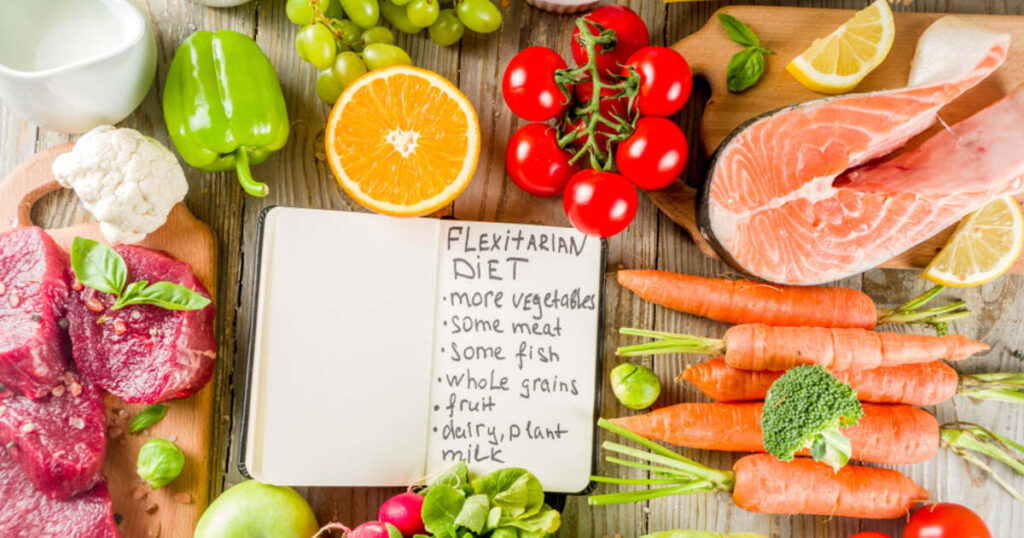The flexitarian diet has gained significant popularity in recent years as a balanced and flexible approach to healthy eating. This dietary pattern combines the benefits of plant-based eating with the occasional inclusion of animal products, offering a middle ground between strict vegetarianism and a traditional omnivorous diet.
As more people become aware of their food choices’ health and environmental impacts, the flexitarian diet has emerged as a practical and sustainable option for those looking to make positive changes without eliminating animal products from their meals.
Read More: Digital News Planet
What is the Flexitarian Diet?
The term “flexitarian” is a combination of the words “flexible” and “vegetarian,” aptly describing the nature of this eating pattern. The flexitarian diet is primarily plant-based but allows for the occasional consumption of meat, fish, dairy, and eggs. Unlike strict vegetarian or vegan diets, flexitarian doesn’t eliminate any food groups, making it a more adaptable and inclusive approach to healthy eating.

Fundamental Principles of the Flexitarian Diet
- Plant-centric focus: Most meals are based on plant foods, including fruits, vegetables, whole grains, legumes, nuts, and seeds.
- Flexibility with animal products: Meat, fish, dairy, and eggs are consumed moderately, typically a few times a week or less.
- Emphasis on whole, minimally processed foods: The diet encourages the consumption of natural, unrefined foods over heavily processed alternatives.
- Sustainability: Environmental considerations often influence food choices, emphasizing reducing meat consumption.
- Personalization: No strict rules allow individuals to tailor the diet to their preferences, cultural background, and nutritional needs.
The History and Evolution of the Flexitarian Diet
While reducing meat consumption is not new, registered dietitian Dawn Jackson Blatner coined “flexitarian” in the early 2000s. In her 2009 book “The Flexitarian Diet: The Mostly Vegetarian Way to Lose Weight, Be Healthier, Prevent Disease, and Add Years to Your Life,” Blatner popularized the idea of a flexible, primarily plant-based approach to eating.
Since then, the flexitarian diet has become a more accessible alternative to strict vegetarian or vegan diets. Nutrition experts and organizations have recognized it as a healthy and sustainable eating pattern with the potential to address both personal health concerns and broader environmental issues.
Health Benefits of the Flexitarian Diet
The flexitarian diet combines many of the health benefits associated with plant-based diets while allowing for the occasional consumption of animal products. Research has shown that this eating pattern can offer numerous health advantages:

1: Weight Management
Studies have found that individuals following a flexitarian diet tend to have lower body mass indexes (BMIs) and reduced obesity rates than those following traditional Western diets. The emphasis on plant-based foods, which are generally lower in calories and higher in fibre, can contribute to better weight management and satiety.
2: Improved Heart Health
The flexitarian diet‘s focus on plant-based foods rich in fibre, antioxidants, and healthy fats can positively impact cardiovascular health. Research has shown that flexitarians often have lower blood pressure, reduced cholesterol levels, and a decreased risk of heart disease compared to regular meat-eaters.
3: Reduced Risk of Type 2 Diabetes
Several studies have linked plant-based diets, including the flexitarian diet, to a lower risk of developing type 2 diabetes. The high fibre content and emphasis on whole grains can help regulate blood sugar levels and improve insulin sensitivity.
4: Lower Cancer Risk
While more research is needed, some studies suggest that the flexitarian diet may be associated with a reduced risk of certain types of cancer, particularly colorectal cancer. This may be due to the higher intake of fruits, vegetables, and whole grains, which are rich in cancer-fighting compounds.
5: Improved Digestive Health
The high fibre content of the flexitarian diet can promote better digestive health by supporting a diverse and healthy gut microbiome. This can improve digestion, reduce inflammation, and improve overall health.
6: Increased Nutrient Intake
By emphasizing various plant-based foods, the flexitarian diet can help ensure a diverse intake of essential nutrients, including vitamins, minerals, and phytochemicals. The occasional inclusion of animal products can also help prevent potential nutrient deficiencies associated with strict vegetarian or vegan diets.
Environmental Benefits of the Flexitarian Diet
In addition to personal health benefits, the flexitarian diet has gained attention for its potential positive impact on the environment:
1: Reduced Carbon Footprint
The flexitarian diet can significantly lower an individual’s carbon footprint by reducing overall meat consumption, particularly red meat. Livestock production is a major contributor to greenhouse gas emissions, and even small reductions in meat intake can have a meaningful impact.
2: Conservation of Water Resources
Animal agriculture requires substantial amounts of water. The flexitarian diet can help conserve water resources and reduce water usage in food production by shifting towards more plant-based meals.
3: Preservation of Biodiversity
Reducing demand for animal products can help slow deforestation and habitat destruction associated with livestock farming, potentially helping to preserve biodiversity and protect endangered species.
4: Sustainable Land Use
Plant-based foods generally require less land to produce than animal products. The flexitarian diet‘s emphasis on plant foods can contribute to more efficient and sustainable land use practices.
How to Adopt a Flexitarian Diet
Transitioning to a flexitarian diet can be gradual, allowing individuals to make sustainable changes over time. Here are some strategies for adopting this eating pattern:

1: Start with Meatless Mondays
Begin by designating one day a week as meat-free. This can help you explore new plant-based recipes and gradually increase your comfort with vegetarian meals.
2: Experiment with Plant-Based Protein Sources
Incorporate a variety of plant-based proteins into your diet, such as:
- Legumes (beans, lentils, chickpeas)
- Tofu and tempeh
- Quinoa and other whole grains
- Nuts and seeds
- Plant-based meat alternatives
3: Reduce Meat Portion Sizes
When you include meat in your meals, consider it a side dish rather than the main focus. Aim to fill half your plate with vegetables, a quarter with whole grains, and the remaining quarter with a small portion of meat or plant-based protein.
4: Explore New Cuisines
Many global cuisines offer delicious vegetarian options. Experiment with Indian, Mediterranean, Middle Eastern, or Asian dishes emphasizing plant-based ingredients.
5: Make Gradual Substitutions
Slowly replace animal products with plant-based alternatives in your favourite recipes. For example, mushrooms can be used instead of ground beef in tacos or spaghetti sauce.
6: Focus on Whole Foods
Emphasize whole, minimally processed foods in your diet. Choose fresh fruits and vegetables, whole grains, and legumes over heavily processed meat alternatives or plant-based junk food.
7: Plan Your Meals
Meal planning can help ensure a balanced diet and prevent the temptation to eat convenient meat-based options. Consider preparing plant-based meals in bulk for easy weekday lunches or dinners.
8: Be Mindful of Nutrient Intake
While the flexitarian diet can provide all necessary nutrients, paying attention to potential nutrient gaps is essential, especially if you’re significantly reducing animal product consumption. Essential nutrients to consider include:
- Vitamin B12
- Iron
- Zinc
- Calcium
- Omega-3 fatty acids
Consider speaking with a registered dietitian to ensure you meet all your nutritional needs.
Sample Meal Plan for the Flexitarian Diet
Here’s a sample 7-day meal plan to illustrate how the flexitarian diet might look in practice:

Day 1 (Meatless Monday)
- Breakfast: Overnight oats with berries, chia seeds, and almond milk
- Lunch: Lentil and vegetable soup with whole-grain bread
- Dinner: Stir-fried tofu and mixed vegetables with brown rice
Day 2
- Breakfast: Whole grain toast with avocado and poached egg
- Lunch: Quinoa salad with roasted vegetables and chickpeas
- Dinner: Grilled salmon with sweet potato and steamed broccoli
Day 3
- Breakfast: Greek yoghurt parfait with granola and fresh fruit
- Lunch: Vegetarian chilli with mixed beans and cornbread
- Dinner: Vegetable and chickpea curry with brown rice
Day 4
- Breakfast: Smoothie bowl with spinach, banana, berries, and plant-based protein powder
- Lunch: Whole grain wrap with hummus, falafel, and mixed greens
- Dinner: Small portion of grilled chicken with roasted vegetables and quinoa
Day 5
- Breakfast: Whole grain cereal with almond milk and sliced banana
- Lunch: Tomato and lentil soup with a side salad
- Dinner: Vegetarian pizza with whole wheat crust, topped with vegetables and plant-based cheese
Day 6
- Breakfast: Tofu scramble with mixed vegetables and whole grain toast
- Lunch: Pasta salad with cherry tomatoes, olives, and white beans
- Dinner: Baked fish with roasted Brussels sprouts and wild rice
Day 7
- Breakfast: Whole grain waffles with almond butter and fresh berries
- Lunch: Buddha bowl with mixed greens, roasted sweet potato, avocado, and edamame
- Dinner: Vegetable and bean enchiladas with a side of guacamole
This meal plan demonstrates how the flexitarian diet can incorporate various plant-based meals while including some animal products in moderation.
Common Myths and Misconceptions About the Flexitarian Diet
As with any popular dietary approach, several myths and misconceptions surround the flexitarian diet. Let’s address some of the most common ones:
Myth 1: Flexitarians Don’t Get Enough Protein
Reality: The flexitarian diet can quickly provide adequate protein through plant-based sources (legumes, nuts, seeds, whole grains) and occasional animal products. Many plant foods are rich in protein, and combining different plant protein sources can provide all essential amino acids.
Myth 2: The Flexitarian Diet is Too Restrictive
Reality: One key advantage of the flexitarian diet is its flexibility. Unlike strict vegetarian or vegan diets, flexitarian allows for occasional meat consumption, making it easier to adapt to various social situations and personal preferences.
Myth 3: Flexitarian Meals are Boring and Unsatisfying
Reality: The flexitarian diet encourages exploring various plant-based foods and cuisines, potentially leading to a more diverse and exciting diet. With creativity and proper meal planning, flexitarian meals can be just as satisfying as traditional meat-based dishes.
Myth 4: The Flexitarian Diet is Expensive
Reality: While some speciality plant-based products can be pricey, many staple foods in the flexitarian diet (such as beans, lentils, rice, and seasonal vegetables) are often more affordable than meat. By reducing meat consumption, many people find that their grocery bills decrease.
Myth 5: Flexitarians Can’t Build Muscle or Maintain Athletic Performance
Reality: Many successful athletes follow plant-based or flexitarian diets. With proper planning and attention to nutrient intake, the flexitarian diet can support muscle growth and athletic performance as effectively as a traditional diet.
Potential Challenges of the Flexitarian Diet and How to Overcome Them
While the flexitarian diet is generally considered accessible and adaptable, some individuals may face challenges adopting this eating pattern. Here are some common obstacles and strategies to overcome them:
Social Situations and Dining Out
Challenge: Navigating social events or restaurant menus that are heavily meat-focused.
Solution:
- Communicate your dietary preferences to hosts or dining companions in advance.
- Look for restaurants with diverse menu options, including vegetarian dishes.
- Be flexible and choose the most plant-forward options available when dining out.
Nutrient Adequacy
Challenge: Ensuring adequate intake of nutrients typically found in animal products, such as vitamin B12, iron, and zinc.
Solution:
- Educate yourself about plant-based sources of these nutrients.
- Consider taking supplements if necessary, especially vitamin B12.
- Include a variety of nutrient-dense plant foods in your diet.
- Consult with a registered dietitian for personalized advice.
Cooking Skills and Recipe Ideas
Challenge: Learning to prepare satisfying plant-based meals, mainly if you’re used to meat-centric cooking.

Solution:
- Invest in an excellent plant-based cookbook or follow vegetarian food blogs for inspiration.
- Start with familiar recipes and gradually replace meat with plant-based alternatives.
- Experiment with new ingredients and cooking techniques.
- Attend cooking classes or watch online tutorials focused on plant-based cooking.
Family Resistance
Challenge: Dealing with family members who are resistant to reducing meat consumption.
Solution:
- Explain the health and environmental benefits of the flexitarian diet.
- Introduce changes gradually and involve family members in meal planning and preparation.
- Prepare dishes that can be easily customized, allowing others to add meat if desired.
- Lead by example and share delicious plant-based meals with your family.
Cravings for Meat
Challenge: Managing cravings for meat, especially in the early stages of adopting a flexitarian diet.
Solution:
- Allow yourself to eat meat occasionally, which aligns with flexitarian principles.
- Explore umami-rich plant-based foods that satisfy savoury cravings (e.g., mushrooms, fermented foods, nutritional yeast).
- Try plant-based meat alternatives to help with the transition.
- Focus on creating satisfying, flavorful plant-based meals that don’t leave you feeling deprived.
The Future of the Flexitarian Diet
As concerns about personal health, animal welfare, and environmental sustainability continue to grow, the flexitarian diet will likely gain even more popularity in the coming years. Several trends and developments suggest a bright future for this eating pattern:
Increased Availability of Plant-Based Options
The food industry is responding to the growing demand for plant-based products with an ever-expanding range of meat, dairy, and egg alternatives. This trend makes it easier for people to adopt a flexitarian diet without feeling restricted.
Integration into Public Health Recommendations
Many national dietary guidelines are beginning to emphasize the importance of plant-based eating while reducing meat consumption, aligning closely with the principles of the flexitarian diet. This official recognition may lead to increased adoption of flexitarian practices.
Environmental Policy and Climate Change Mitigation
As governments and organizations seek ways to reduce greenhouse gas emissions and combat climate change, promoting reduced meat consumption through approaches like the flexitarian diet may become part of broader environmental policies.
Technological Advancements in Food Production
Ongoing research and development in cellular agriculture and plant-based meat alternatives may provide even more options for those following a flexitarian diet, potentially making it easier to reduce reliance on traditional animal agriculture.
Personalized Nutrition
Nutritional science and genetic research advances may lead to more personalized dietary recommendations. The flexitarian diet’s flexibility makes it well-suited to adaptation based on individual needs and preferences.
Conclusion
The flexitarian diet offers a balanced and flexible approach to healthy eating that can benefit personal health and the environment. By emphasizing plant-based foods while allowing for occasional consumption of animal products, this dietary pattern provides a practical middle ground between strict vegetarianism and traditional omnivorous diets.
As more people become aware of the impact of their food choices on their health and the planet, the flexitarian diet is likely to continue gaining popularity. Its adaptability to various cultural, personal, and nutritional needs makes it an accessible option for those looking to change their eating habits without feeling overly restricted.
Whether you’re motivated by health concerns, environmental considerations, or simply a desire to explore a more plant-centric way of eating, the flexitarian diet offers a sustainable and enjoyable path forward. By embracing the principles of flexitarian and gradually incorporating more plant-based meals into your diet, you can take meaningful steps towards a healthier lifestyle and a more sustainable food system.





